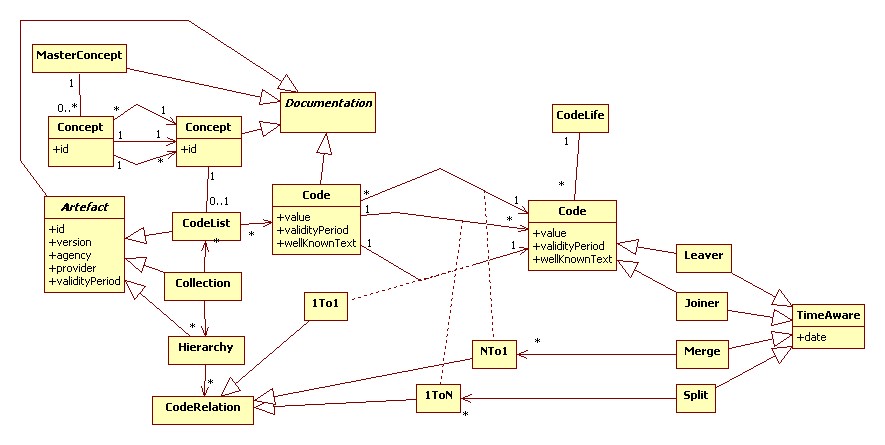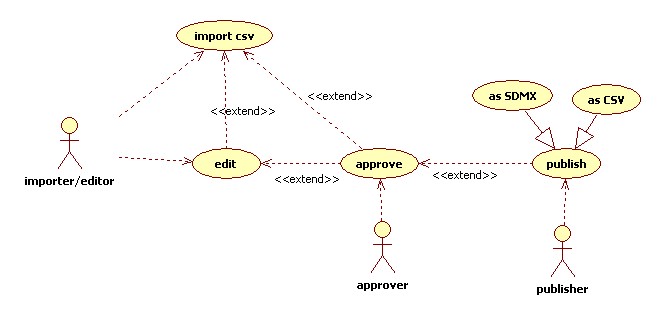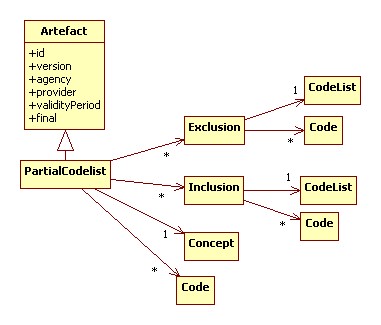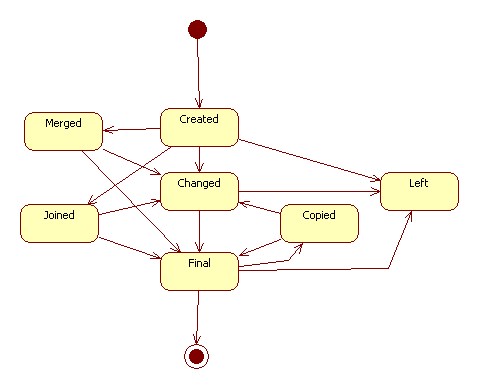Difference between revisions of "CodelistManager"
(Created page with "=CoreDomain= image:CoreDomainModel.jpg =Core Use Cases= image:CoreUseCases.jpg ==UseCase import csv== A good example for the import csv file is the ASFIS species li...") |
(→Core Use Cases) |
||
| Line 5: | Line 5: | ||
[[image:CoreUseCases.jpg]] | [[image:CoreUseCases.jpg]] | ||
| + | |||
| + | =Multi language= | ||
| + | [[image:Documentation.jpg]] | ||
| + | =PartialCodelist= | ||
| + | [[image:PartialCodelist.jpg]] | ||
| + | =Statechart of a Code= | ||
| + | [[image:StatechartDiagramCode.jpg]] | ||
==UseCase import csv== | ==UseCase import csv== | ||
Revision as of 17:35, 11 April 2012
CoreDomain
Core Use Cases
Multi language
PartialCodelist
Statechart of a Code
UseCase import csv
A good example for the import csv file is the ASFIS species list. The Asfis species list is a zip file, containing the file ASFIS_sp_Feb_2011.txt, which is a csv file. The implicit hierarchies in this file are documented here. http://www.fao.org/fishery/collection/asfis/en documented here http://km.fao.org/FIGISwiki/index.php/ASFIS_SDMX_Codelist
After having imported the ASFIS file, the following codelists are **interpreted**:
- ASFIS Species Alpha 3 Codelist
- ASFIS Species Taxonomic Codelist
- ASFIS Species Family Taxonomic codelist
- ASFIS Species Order Taxonomic codelist
and hierarchies:
- Relation ASFIS Species Taxonomic code - Alpha 3 code
- Relation ASFIS Family - Species
- Relation ASFIS Order - Family
and collections
- ASFIS List of Species
- Interpreted** means that the system is capable of understanding all the implicit relations in the tabular format file like the the **ASFIS_sp_Feb_2011.txt** file and shows in the UI distinguished codelists, hierarchies and collections. The **ASFIS_sp_Feb_2011.txt** file results therefore in 4 codelits, 3 hierarchies and 1 collection.
The collection //ASFIS List of Species// is containing the same information as the original ASFIS_sp_Feb_2011.txt file.
UseCase create new version of an Artefact
- Start from scratch, import, or copy an existing //Artefact//in order to work on a new version of an //Artefact//.
- Delete codes/hierarchies
- Add codes/hierarchies
- Edit codes/hierarchies
- View deleted codes/hierarchies
- View added codes/hierarchies
- View edited codes/hierarchies
- Make //Artefact// final
UseCase approve
A collection, codelist, hierarchy is approved and is ready to be published.
UseCase publish
A //Collection//, //Codelist// or //Hierarchy// can be published through SDMX, CSV:
- Codelists are published as SDMX codelists according the SDMX REST specifications.
- Hierarchies are published as SDMX hierarchical codelists according the SDMX REST specifications
- Collections are published as zip, txt, zip containing a txt file or zip containing a csv file. Such a collection would represent for instance the original ASFIS txt file.
UseCase publish geospatial referenced codelist
When codes have a geospatial reference through the attribute wellKnownText, it can be exported/published as a layer/WFSWeb Feature Service. Details of this usecase need to be refined further.
UseCase DiffReport
- User select artefact(Codelist, HierarchicalCodelist or Collection).
- User selects a certain version from that artefact.
- User selects another version from that same artefact.
- User clicks on generate DiffReport and views the DiffReport
The report shows:
- Codes added.
- Codes deleted.
- Number of codes in the first and second selected version.
Rules
- A code can become final when:
- it is published in a codelist
- it is made final
- A code can becomes non final when it was final and has been changed
- A code is non final when it is created
- A code can only change from final to non-final when it was not yet published in a codelist
- Changing the validityPeriod, wellKnownText or value of a final code will result in a copy of that code. The new code will be non final.
- Creating a new //Code// means also creating a new //CodeLife//
- Making a copy of a //Code// results in adding a link from that new //Code// to its //CodeLife//
- An //Artefact// or //Code// has a type:
|| **Type** (Artefact or Code) || **Description** || || Local || This is the default type. Created or imported and the further lifecycle and management is **in** the system || || ImportedImmutable || Imported from outside and cannot be changed. Will have //CodeLife.// The lifecycle and management is outside of the system but will be followed and monitored in the system. || || LifeLinked || Is only linked, not stored and at most cached. Works in principle only in case the outside link is available. Will not have a //CodeLife//, the lifecycle and management is outside of the system ||
- )This table is not yet integrated in the model.
Nice to haves
- Integration with SharePoint
- Support for CMIS
- Export to OWL
- Export to SKOSS
- Export to RDF




